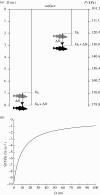Fractional rate of change of swim-bladder volume is reliably related to absolute depth during vertical displacements in teleost fish
- PMID: 20190038
- PMCID: PMC2894882
- DOI: 10.1098/rsif.2009.0522
Fractional rate of change of swim-bladder volume is reliably related to absolute depth during vertical displacements in teleost fish
Abstract
Fish must orient in three dimensions as they navigate through space, but it is unknown whether they are assisted by a sense of depth. In principle, depth can be estimated directly from hydrostatic pressure, but although teleost fish are exquisitely sensitive to changes in pressure, they appear unable to measure absolute pressure. Teleosts sense changes in pressure via changes in the volume of their gas-filled swim-bladder, but because the amount of gas it contains is varied to regulate buoyancy, this cannot act as a long-term steady reference for inferring absolute pressure. In consequence, it is generally thought that teleosts are unable to sense depth using hydrostatic pressure. Here, we overturn this received wisdom by showing from a theoretical physical perspective that absolute depth could be estimated during fast, steady vertical displacements by combining a measurement of vertical speed with a measurement of the fractional rate of change of swim-bladder volume. This mechanism works even if the amount of gas in the swim-bladder varies, provided that this variation occurs over much longer time scales than changes in volume during displacements. There is therefore no a priori physical justification for assuming that teleost fish cannot sense absolute depth by using hydrostatic pressure cues.
Figures

 , plotted against depth (D). The volume (V) occupied by a given amount of gas is inversely proportional to its pressure. Hence, because the percentage change in pressure owing to a given vertical displacement decreases with increasing depth, it follows that the relative rate of change in the volume of the swim-bladder also decreases with increasing depth.
, plotted against depth (D). The volume (V) occupied by a given amount of gas is inversely proportional to its pressure. Hence, because the percentage change in pressure owing to a given vertical displacement decreases with increasing depth, it follows that the relative rate of change in the volume of the swim-bladder also decreases with increasing depth.References
-
- Alexander R. McN. 1959a. The physical properties of the swimbladder in intact Cypriniformes. J. Exp. Biol. 36, 315–332.
-
- Alexander R. McN. 1959b. The physical properties of the swimbladders of fish other than Cypriniformes. J. Exp. Biol. 36, 347–355.
-
- Alexander R. McN. 1961. The physical properties of the swimbladders of some South American Cypriniformes. J. Exp. Biol. 38, 403–410.
-
- Blaxter J. H. S., Tytler P. 1972. Pressure discrimination in teleost fish. Symp. Soc. Exp. Biol. 26, 417–443. - PubMed
Publication types
MeSH terms
Grants and funding
LinkOut - more resources
Full Text Sources

